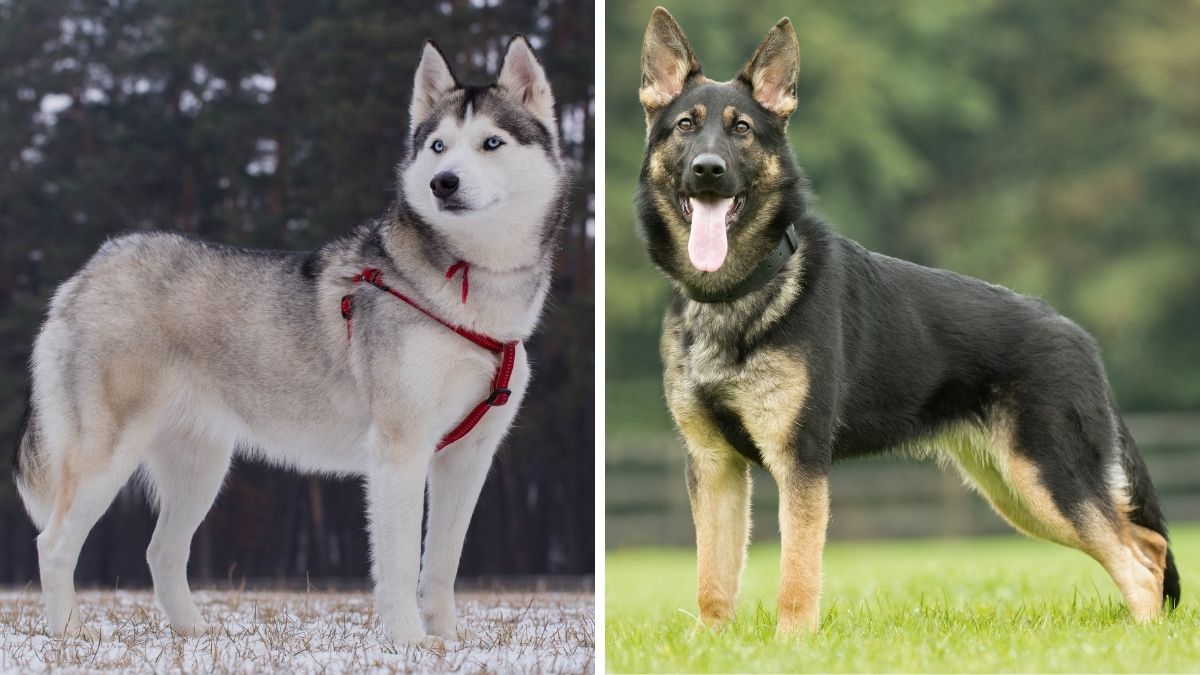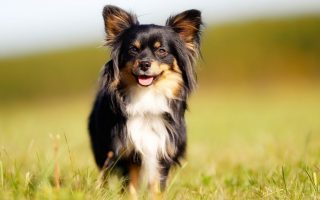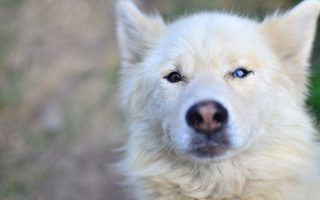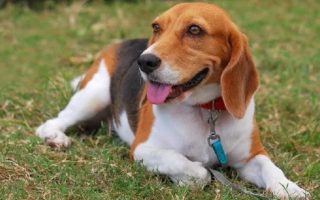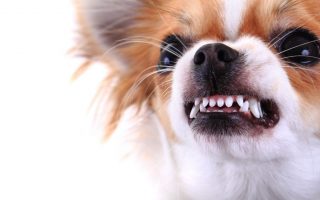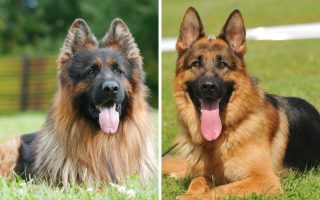The German Shepherd and Siberian Husky are both popular breeds, with many of them getting into families each year.
They also look alike, but not so much that you won’t be able to tell the difference.
Both are working dogs— though classified under different groups by the American Kennel Club—as that’s what they were made for.
However, one may be more suited for your family than the other. To be clear, both are good for families, as their popularities can attest.
However, you may find that not only do you prefer one over another, but that one is more in line with your pet parenting goals.
Let’s look into both breeds in detail and draw out what makes them similar and what puts them apart.
Siberian Husky vs German Shepherd Comparison
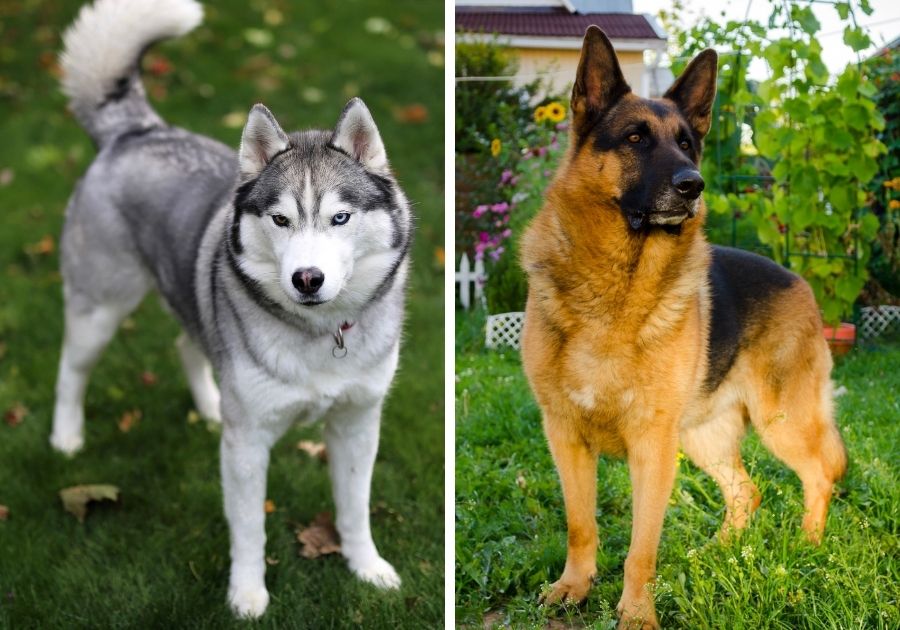
| Comparison | Siberian Husky | German Shepherd |
|---|---|---|
| Height | 20 to 24 inches | 22 to 26 inches |
| Weight | 35 to 65 pounds | 50 to 90 pounds |
| Coat Type | Double, dense, straight | Double, wiry, soft |
| Coat Colors | White, black, gray and white, black and tan | Black, black and cream, black and red, white, silver |
| Temperament | Outgoing, friendly, intelligent | Aloof, loyal, intelligent |
| Trainability | High | High |
| Life Expectancy | 12 to 15 years | 10 to 14 years |
| Energy | High | High |
| Puppy Price | $800 to $2,000 | $1,500 to $3,500 |
Siberian Husky Dog Breed – All You Should Know
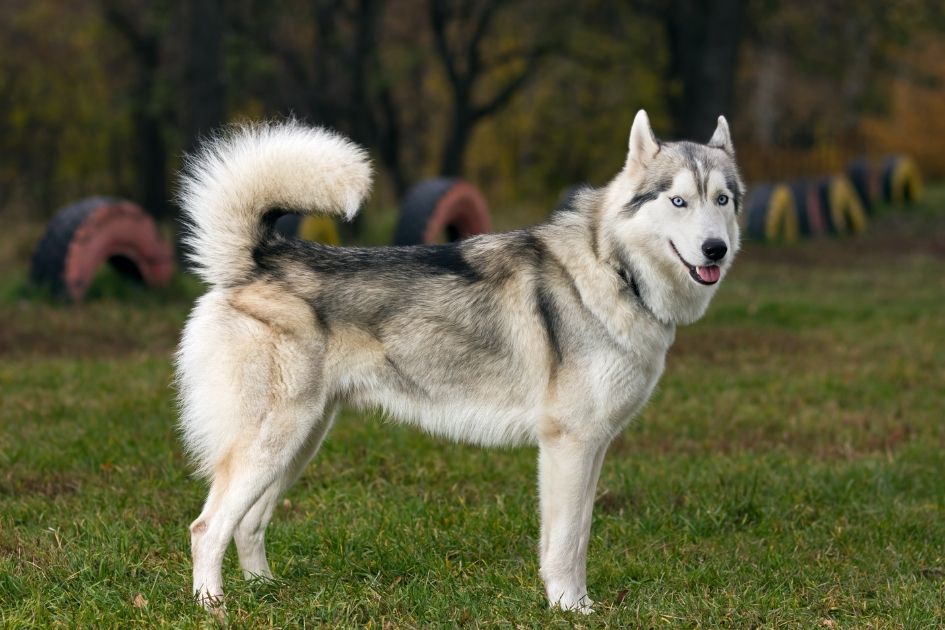
Siberian Husky History and Origin
The Siberian Husky originated from Siberia, where it lived with members of the Chukchi tribe, a nomadic group of people.
They had a slightly different appearance than what we know today and played the role of both sledding and companionship to the Chukchis.
According to DNA testing, the Siberian Husky is one of the oldest dog breeds.
It got into the United States in 1908 during the gold rush and was used as a sled dog in Alaska. It also participated in races.
It was in the United States—and North America as a whole—that the Siberian Husky evolved to what we know today.
In 1930, there were no Siberian huskies left in Siberia, and the breed became a part of North America. In 1938, the Siberian Husky Club of America was founded.
Before then, in 1930, the American Kennel Club recognized this breed. The Canadian Kennel Club recognized it in 1939.
Siberian Husky Appearance
The Siberian Husky is a medium-sized breed that looks like an arctic wolf. It weighs between 35 and 65 and has a height that goes from 20 to 24 inches.
It has a dense double coat that helped protect it from the harsh weather in Siberia. The coat comes in a lot of colors, and markings are permitted too.
Some of the colors are black, white, and gray. During the spring, when the weather becomes warmer, the Siberian Husky sheds a lot.
Besides the coat, what gives the Husky the vibes of a wolf is its facial appearance. Its ears perk up, and it has a pointed snout, similar to a wolf.
The eyes of the Siberian Husky are either blue or brown. Huskies can experience heterochromia, where an individual will have different eye colors.
Overall, the Siberian Husky strikes the onlooker as feral, one reason its fans love it.
Siberian Husky Personality
Though it looks intimidating and wolf-like, the Siberian Husky is nothing like a wolf in terms of personality.
Huskies are friendly and extroverted, and they have no issues meeting a new person, especially when properly socialized.
This breed considers everyone as a friend and is on the lookout for more.
With family, the Siberian Husky is even more affectionate. It loves to be around its folks and doesn’t enjoy being alone, but it isn’t too clingy either.
The Husky has some measure of independence, which means it can do things on its own as long as you don’t leave it alone for hours.
Its independence has a downside, though. The Husky isn’t an eager-to-please breed and may want to do things it’s way.
Because it is a pack animal, asserting your position as the leader goes a long way. However, it will still try to challenge you now and then.
The Siberian Husky is also energetic and highly distracted, which can slow down your training progress.
You should be consistent and firm with the Husky and give it enough exercise too.
German Shepherd Dog Breed – All You Should Know
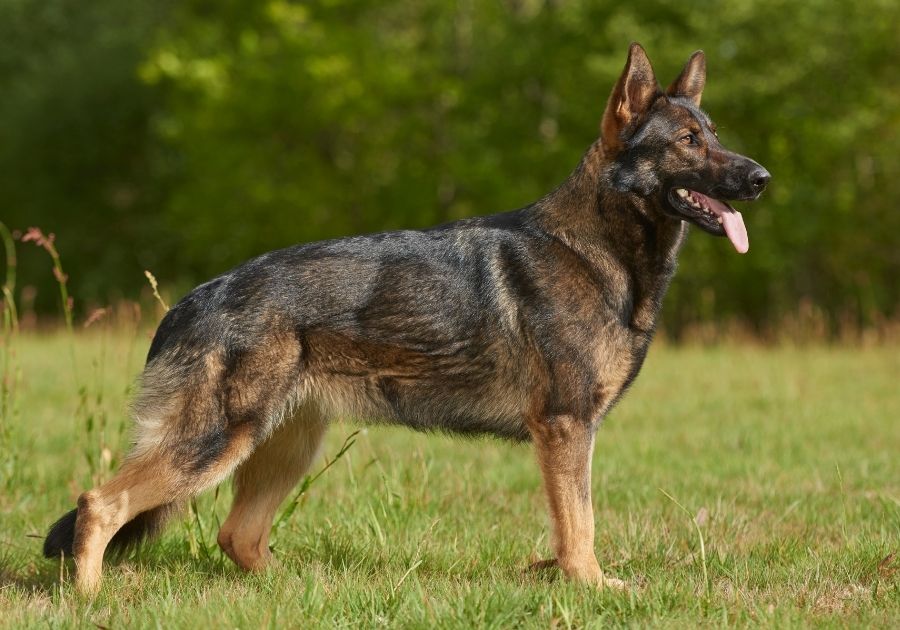
German Shepherd History and Origin
The German Shepherd dog’s history has a much different angle when compared to the Husky’s own.
It came into existence in 1899, making it relatively new. The first breeder of the German Shepherd was Captain Max von Stephanitz, a German soldier.
He intended to develop a herding dog breed as he realized that though there were many herding dogs in Germany, there was no particular breed.
He was successful in his mission, but as Germany evolved and needed less of herding dogs, he had to change the course of the German Shepherd Dog. Thus began this breed’s career in the military.
The GSD dog fought in the First World War under the German army, and it served as a Red Cross dog, rescuer, messenger, and guard, among others.
It was during the war that this breed caught the attention of Americans, and after that, the GSD began to thrive in the United States.
There was a little challenge, though. In the years following the First World War, Germany wasn’t the world’s favorite country, to say the least.
Thus, the American Kennel Club changed the breed’s name to the Shepherd Dog in 1917. This happened a long time after its recognition in 1908.
The British Kennel Club upturned the name completely, renaming it the Alsatian Wolf Dog.
In 1931, the American Kennel Club reverted to the old name. In 1977, the British Kennel Club did the same.
Some people still call the German Shepherd the Alsatian Dog to date, however.
German Shepherd Appearance
The German Shepherd is a big dog that weighs between 50 and 90 pounds and grows to 22 and 26 inches tall.
It has a double coat that no doubt served as protection during its herding and wartime days.
Some German Shepherd features long hair; others are more medium length. It has a lot of colors like black, black and cream, black and red, etc.
Expect a lot of shedding from this breed. The breed has perked-up ears but is in no way like a wolf.
Its eyes are dark, with a bushy tail and a long snout. Its muscular and agile body earned it the constant approval of law enforcement.
German Shepherd Personality
The German Shepherd tends to be aloof towards strangers, an instinct that helped it survive in its herding days. This makes it both a good watchdog and guard dog.
However, as a family companion, you should socialize so it not to be too wary to the point of aggression.
Aggression isn’t a desirable trait in the German Shepherd, but when it feels threatened and has to defend its family, it can become ferocious.
This courageous breed doesn’t back down from a fight, so woe to any intruder that comes across it.
Many people who get a German Shepherd want it to be a guard dog, and that’s a good thing.
This breed is a worker and won’t be content with snuggles and doing nothing all day.
GSDs have an independent mind and can pose a challenge during training, but it is trainable. It also needs exercise, and once it has that, it can adapt to any environment.
Siberian Husky vs German Shepherd – What’s The Difference?
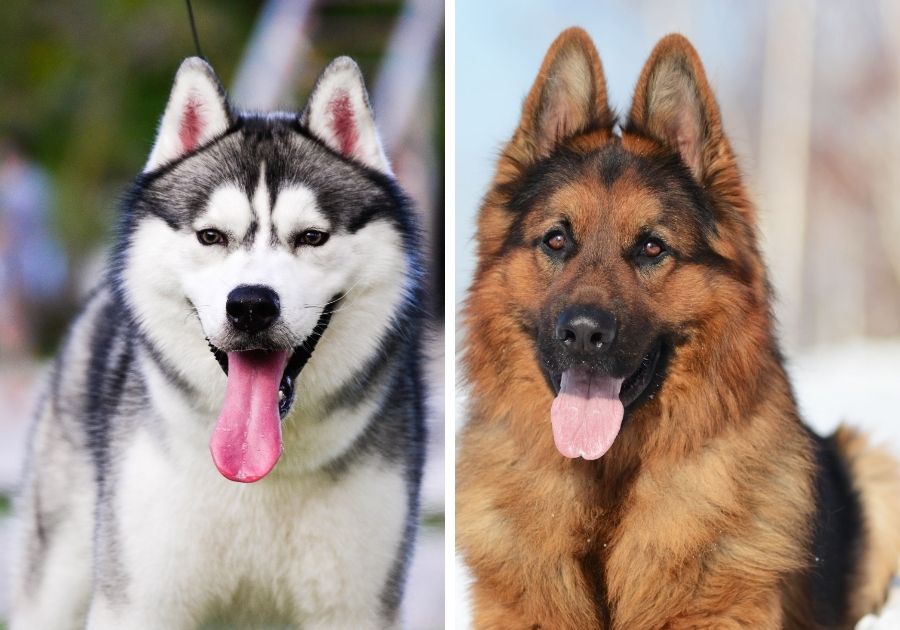
There are some obvious differences between the Siberian Husky and the German Shepherd in size, appearance, temperament, coat color and type, and lifespan.
We will compare both breeds using 12 categories.
Size and Appearance
The German Shepherd is the bigger dog of the duo. It is classified as a medium to large dog, while the Siberian Husky is solely medium-sized.
The German Shepherd is taller than the Siberian Husky by around 2 inches and weighs a lot more, with a difference of more than 10 pounds.
In some ways, the German Shepherd and the Siberian Husky look alike. Their perky ears and facial shape give them that resemblance, but it is easy to tell them apart.
The German Shepherd has a longer body and tends to be more muscular than the slender Siberian Husky.
Both breeds are double coated, but the colors aren’t the same. The most popular color of the German Shepherd is black and tan, while the Siberian Husky is usually known for its white and grey color.
Both breeds have the same head shape but different eye colors. German Shepherds have a darker shade, while the common eye color of the Siberian Husky is blue.
Energy
Given the size difference, one would imagine that the Siberian Husky would fit a smaller space better.
However, the German Shepherd is more suitable for an apartment than a Siberian Husky. This is due to the difference in energy level.
The Siberian Husky is highly energetic, making it a poor choice for an apartment.
Not surprisingly, the Husky needs more exercise than the German Shepherd.
The latter will be satisfied with an hour of physical activities, but Huskies can keep going 30 minutes more before calming down.
Their exercise preferences tend to differ too. The German Shepherd enjoys games like fetch and agility, while the Siberian Husky loves long walks and running.
If you own a German Shepherd in an apartment, ensure it doesn’t live in your flat and scare other tenants.
In a wider environment, you need to erect a fence for both breeds as they are prone to escaping.
Temperament
Both breeds have their strengths and weaknesses, but they do not behave the same.
The German Shepherd is calmer, aloof towards strangers, and fiercely loyal to its family. Siberian Huskies are loyal too but don’t expect this breed to be quiet.
An extrovert to the core, the Siberian Husky wants to be with everyone.
The German Shepherd sees itself as the “herder” of the family, and it assumes that responsibility with seriousness.
The Siberian Husky might look scary to some, but this dog has no desire to guard anyone.
It would rather be found playing or being mischievous than trying to ward off an intruder.
They both love their families and are affectionate, but even the way they love is different. The German Shepherd shows its affection in quieter ways.
Acts of service seem to be its love language, as it will show you love by doing things for you.
The Siberian Husky is more expressive with its affection, and sometimes it can be too enthusiastic.
The Husky is more likely to jump on you with excitement than the German Shepherd.
Overall, both breeds love being around their humans and can suffer from separation anxiety when alone for long. It isn’t a good idea to keep them isolated.
Trainability
Both breeds are trainable and can be domestic pets, but best believe you can’t approach them the same way.
The German Shepherd is eager to please and loves to work, so it will enjoy consistent training sessions. That’s why the cops love GSDs.
They are also willing to please but do need a firm, experienced owner.
The new pet parent might get discouraged by the independent spirit of the German Shepherd and also may not know how to keep this dog occupied enough.
Siberian Huskies are friendly but don’t enjoy training. If given a choice of playing or training, they’d rather play.
The Husky is like that affable kid who skips classes but isn’t disliked by anyone. It is a very poor choice for a first-time pet parent, even more than the GSD.
Training has to look like playtime and should be versatile enough to keep the Husky interested.
Start training early for these two, so you can avoid some behavioral problems they can develop.
The German Shepherd can get too aloof if not socialized early enough, while the Siberian Husky will be too excited around people.
Health and Life Expectancy
Both breeds boast of good health, but they don’t have the same lifespan.
The Siberian Husky is expected to live longer, with a lifespan of 12 to 15 years. The German Shepherd falls shorter at 10 to 14 years.
Both breeds are susceptible to hip dysplasia, a common joint disorder that affects medium to big dogs.
The German Shepherd is also susceptible to Elbow dysplasia, which the Siberian Husky doesn’t always suffer from.
For the German Shepherd, it is recommended to test for both elbow and hip dysplasia.
This breed is also vulnerable to the dangerous Gastric Dilatation Volvulus (GDV), popularly known as bloat. It can as well suffer from degenerative myopathy.
The Siberian Husky is predisposed to eye diseases, so it is recommended to test the eyes through ophthalmologic evaluations.
The Siberian Husky can fall victim to Progressive Retinal Atrophy (which eventually leads to blindness), cataracts, and corneal Dystrophy.
Before getting either breed, ensure that the pup is healthy.
Coat and Grooming
The German Shepherd and Siberian Husky’s double coats have different textures.
While the German Shepherd has a soft undercoat, the topcoat is rough to the touch. Both need the same amount of brushing, a minimum of twice a week.
They are both shedders, and during those seasons, you’d need to brush regularly and get a vacuum cleaner.
Brushing will keep them neat and clear of dead hair, while the vacuum is for your environment.
The Siberian Husky seldom needs bathing because it cleans itself like a cat.
The German Shepherd has no such ability, so you should bathe it once every 2 months.
Fortunately, these breeds don’t drool a lot, fart, or smell. Do not forget to clean their ears, brush their teeth and clip their nails.
Feeding
There isn’t any big difference in the feeding of the Siberian Husky and the German Shepherd, except that members of the Husky breed tend to be pickier.
Both breeds need at least 3 cups of meal per day, which can be divided into two meals.
Many high-quality diets would be suitable for both the Husky and the German Shepherd and ensure you make the right choice.
High-quality products will be protein-filled and have other important ingredients like Omega-3 fatty acids. It will also not need fillers like grain.
The German Shepherd is more vulnerable to obesity than the Siberian Husky as the latter knows when to stop.
Popularity and AKC Recognition
Though the Siberian Husky existed long before the German Shepherd, it got into the United States after the GSD had set its roots.
The German Shepherd became popular in the United States after the 1st World War and was recognized by the American Kennel Club in 1908.
It was in 1908 that Siberian Husky came into the United States, and it got recognized by the American Kennel Club in 1930.
The AKC registered the German Shepherd under the Herding group in line with its initial role. The Siberian Husky joined other versatile dogs in the Working group.
Both breeds are currently popular, but the GSD ranks higher.
According to the most recent list, the German Shepherd is the 4th most popular breed in the United States, while the Siberian Husky is the 19th.
Price
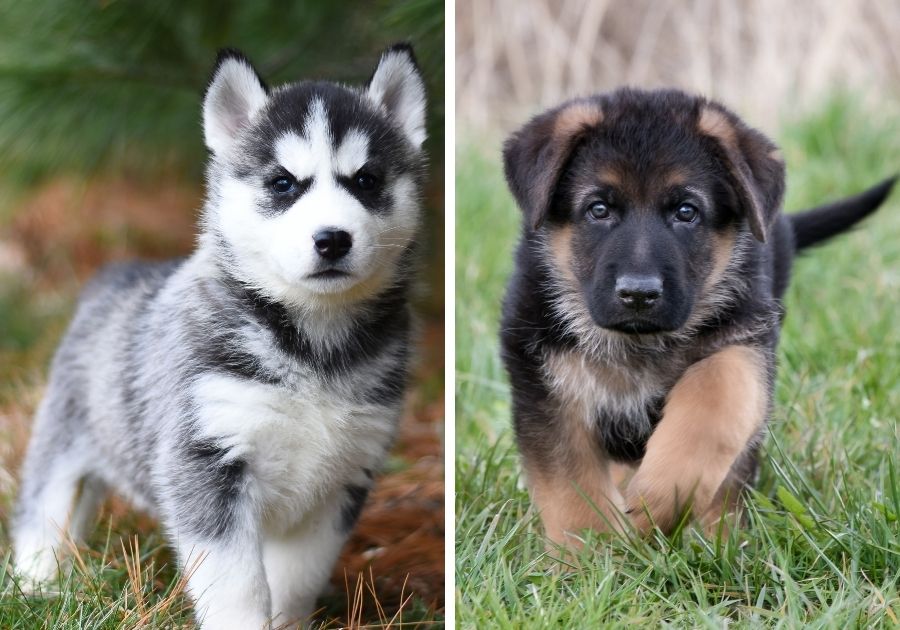
The prices of a standard German Shepherd and Siberian Husky pup are in the same range, but the German Shepherd costs more.
The German Shepherd puppy costs around $1,500 to $3,500 while the Siberian Husky puppy costs around $800 to $2,000. These prices can vary, of course.
Avoid shopping from a puppy mill or a backyard breeder, irrespective of which breed you decide to buy.
Only a reputable breeder can give you the best and most healthy pup. This breeder would be able and willing to quench your doubts and will ask questions too.
You can also choose to adopt, which would be cheaper. Both breeds can be found at rescue shelters, and the adoption fee for both falls between $100 and $500.
The German Shepherd might be more expensive to adopt, but it depends on many factors such as age.
Are They Good Security Dogs?
The German Shepherd is both an excellent guard dog and a watchdog.
This breed is a security asset to its family, and it remains protective as long as it lives. The German Shepherd will defend its life.
The Siberian Husky is alert and can make a good watchdog, but it doesn’t have the qualities of a guard dog.
It can only scare an intruder away with its looks but has no reservations against strangers. Thus, if having a guard dog is a priority, you know which breed to go for.
Are They Good with Kids and Other Pets?
With proper socialization, both breeds are good with kids. The German Shepherd is sometimes seen as a babysitter because of its love for kids, while the Siberian Husky is always up for fun and loves playing around.
The German Shepherd is better suited for a one-pet home, while the Husky will enjoy having other dogs around.
If you introduce the German Shepherd early enough to other dogs, it can get along. However, its protective nature can become a problem.
The same applies to other pets. The Siberian Husky has a high prey drive, making it unfit for a home with smaller animals.
Are They Good Family Dogs?
The Siberian Husky and the German Shepherd are both good for families, but they are not meant for everyone.
Apartment dwellers should best swipe left on the Siberian Husky, and new pet parents need not apply either—but if they insist, the German Shepherd is better.
Before choosing any, be sure you can meet its needs the way it likes. You should also understand what challenges you will face and how to overcome them.
The German Shepherd and the Siberian Husky can be your best friend if you have what it takes to care for them.
Can a Husky beat a German Shepherd?
You won’t find a Siberian Husky fighting a German Shepherd every day, so it is hard to determine who would win in a fight.
That said, the German Shepherd has a natural advantage of size and muscles.
Are Huskies more aggressive than the German Shepherd?
The Siberian Husky can’t be considered more aggressive than the German Shepherd because it is friendlier towards everyone and isn’t protective.
The German Shepherd is more likely to be aggressive than the Siberian Husky.
Siberian Husky vs German Shepherd – The Verdict
Similar, yet very different, the German Shepherd and the Siberian Husky have their unique appeal. Objectively, none is better than the other.
However, you may find that one of these breeds is better for you than the other.
Gauging their energy level, friendliness, size, trainability, and health can help you determine which you’d have as a family dog.
You May Also Like:
Belgian Malinois vs German Shepherd: 11 Key Differences

